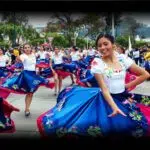Separation Day is celebrated on November 3 each year and is also known as Panama’s National Day. It marks Panama’s separation from Colombia to become its own full-fledged Republic. Panama and Colombia used to be a single nation known as New Grenada or Gran Colombia back in the 1800s when they achieved independence from Spain, their colonizer. However, the fuse that sparked Panama’s revolution against Colombia was the proposal to build the Panama Canal across the Isthmus of Panama — something Colombia opposed and Panama was amenable to. So, as with most great revolutions, conflict of opinion was the reason for this country finally becoming its own republic.
History of Separation Day
Separation Day was established as a mark of Panama’s independence from the South American nation of Colombia in 1903. Interestingly, Panama has its own independence day already, which is celebrated on November 28, the day that Panama gained its freedom from Spain, in 1821. That breaking away was led by one of the most famous leaders in South American history — Simon Bolivar. He was a Venezuelan leader who fuelled the fires of revolution and enabled Panama and Colombia to break free from Spain, among other South American countries like Ecuador and Venezuela.
When Panama left Spanish rule, it came under the Republic of Greater Colombia (or Gran Colombia). Despite this monumental step of emancipation from Spain, the Panamanians weren’t satisfied. They had an enduring passion to become their own nation, and they almost became independent from Columbia in 1831, which was when Ecuador and Venezuela parted ways with the Republic of Greater Colombia.
Around the late 1800s, the French decided that building a canal across the Isthmus of Panama would be a great way to make the Pacific accessible, hence the Panama Canal project was born. However, the French failed and abandoned the project. It was then that the U.S. also stepped in and attempted to complete construction, but they faced opposition from the Government of Colombia. It was therefore in the United States’ best interest to support the Panamanian separatist movement, as Colombia and Panama were in disagreement over the right of the U.S. to build and control the canal.
With aid from the U.S., Panama successfully broke away from Colombia in 1903. It was then that Panama signed the “Hay-Bunau-Varilla Treaty” which recognized the Republic of Panama as an independent nation, and allowed the U.S. to resume construction of the Panama Canal. The reason Panama was in favor of the canal was that it would help improve their socio-economic conditions. By 1914, the Panama Canal was completed and by 1999, President Jimmy Carter handed full control of it to the Government of Panama.
Today, the motto of Panama is ‘Pro Mundi Beneficio’ (‘For the benefit of the world’), and this stands to reason, because of the great importance of the Panama Canal to international trade and other commerce-related affairs. So deeply does their patriotism run that many Panamanians even adopted Ruben Blades’ song, ‘Patria’ (‘Motherland’), as their unofficial national anthem. Blades is a Panamanian musician and activist, and his song ‘Patria’ (released in 1988) talks about the meaning of the word ‘homeland’.
Separation Day timeline
European explorer, Rodrigo de Bastidas, is the first European to discover the Isthmus of Panama.
The natives of Panama become subject to Spain as their sovereign ruler for over 300 years.
Pedro Arias Davila founds Nuestra Señora de la Asunción de Panamá, which later is known as Panama City — the first European settlement to be established on the Pacific coast.
Aided by the U.S., Panama separates from Colombia and becomes an independent republic.
U.S. President Jimmy Carter hands over full control of the Panama Canal to the Panamanian government.
Separation Day FAQs
Why did Colombia lose Panama?
When the Government of Colombia refused to agree to the U.S. proposal to build the Panama Canal, a Panamanian faction rose and revolted, achieving independence for the country. Their revolt was successful because it was backed by a French-American company, the Panama Canal Company because both the French and Americans saw it in their best interest to build the Panama Canal across the Isthmus of Panama.
Why does Panama celebrate two Independence Days?
Panama celebrates two independence days because, at different points in history, it was subjugated by two different nations — once by Spain, and then again by Columbia. Hence, it has two different independence days.
Who liberated Panama?
Simon Bolivar, known as ‘El Libertador’ (‘The Liberator’), was the one who managed to free Panama from under the rule of the Spanish. During that time (between 1819-1822), Panama and Colombia broke away as one unit and were called Gran Panama. Bolivar was a Venezuelan leader who is famous in South American history for not just gaining independence for his country, but also other South American countries like Ecuador, Colombia, and Panama.
Separation Day Activities
Throw a ‘fiesta’
Since actually going to Panama to take part in the general festivities, like parades and fireworks, might be too far-fetched, you can always make it a celebration right where you are. Many Panamanians dress up in their native attire and dance cultural dances like ‘El Tamborito.’ Look up the whole shebang and get festive — and of course, no celebration is complete without food.
Plan your next vacation
Panama has a lot of natural beauty to offer, as well as some 365 islands that belong to it. So, why not plan your next family getaway (or solo trip) to any of these breathtakingly stunning islands, complete with azure skies and turquoise waters? We recommend you get that piggy bank out now.
Immerse yourself in Panama’s culture
As with any nation, Panama is steeped in rich culture and history, which begs exploration. Be it the music, art, dances, food, literature, or any other cultural artifact; we recommend you start your journey right now. We already recommend you give Ruben Blades a listen.
5 Facts About Panama Which Will Have You Packing
Sunrise and sunset on two oceans
Panama is the one place on Earth where you can see the sunrise in the Pacific and sunset in the Atlantic.
Coca-Cola’s first visit outside the U.S.
Panama was the first country to sell Coca-Cola, after the U.S.
Biodiversity galore
The rainforest in Panama is the second largest one in South America and is within the city limits of the capital.
Currency made easy
American tourists rejoice — Panama was the first South American country to adopt the U.S. dollar as its currency.
The wonder of the world
The Panama Canal is counted among the ‘Seven Modern Wonders of the World’ and accounts for a third of the nation’s economy.
Why We Love Separation Day
It celebrates independence
We love freedom and championing the rights of nations to be their own sovereign. Separation Day celebrates just that — the emancipation of a people to build their own nation and future.
It makes history visible
It is so rare to have the opportunity to learn about the history of lesser-known countries. Celebrating this day provides a window into the history of the nation of Panama, giving us the chance to truly appreciate and acknowledge all that has shaped it into what it is today.
It brings Panama into the limelight
We have only scratched the tip of the iceberg of fascinating facts about Panama. For such a small country, there is a world of information to be gleaned. Best-case scenario? Take a trip there yourself and find yourself falling in love.
Separation Day dates
| Year | Date | Day |
|---|---|---|
| 2025 | November 3 | Monday |
| 2026 | November 3 | Tuesday |
| 2027 | November 3 | Wednesday |
| 2028 | November 3 | Friday |
| 2029 | November 3 | Saturday |




















